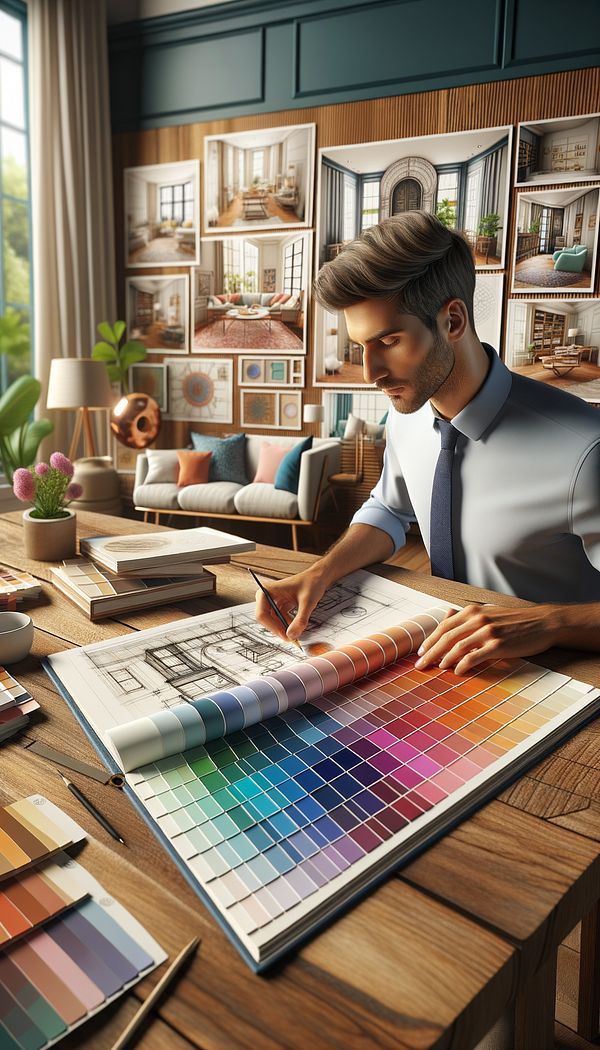What is Hue?
Hue refers to the pure color without tint or shade, determining its place on the color wheel.
Description
In the world of interior design, understanding hue is fundamental to creating vibrant, harmonious, and aesthetically pleasing spaces. Hue is essentially what we commonly refer to as 'color.' It's the base characteristic of a color that distinguishes it from other colors. For example, when we say 'red,' 'blue,' or 'yellow,' we're talking about different hues. These primary hues, along with a mix of secondary and tertiary hues, make up the color wheel – a tool that is instrumental in selecting and combining colors effectively.
Hues play a crucial role in conveying a room's atmosphere, mood, and style. Different hues can evoke different emotions and responses, making color selection a powerful tool in interior design. The use of hue is not just limited to wall paint; it extends to furniture, textiles, decorative objects, and even lighting. Understanding how to balance and coordinate hues enables designers to craft spaces that are both beautiful and functional.
Moreover, the concept of hue is integral to creating color schemes such as monochromatic, analogous, and complementary color schemes. By adjusting the tint, shade, or saturation of a hue, designers can achieve an endless variety of looks and feelings within a space. Hue is not static; it can be manipulated and layered to add depth, contrast, and interest to interior spaces.
Usage
In a mid century modern living room, a designer may choose a vibrant orange hue for the sofa as a nod to the period's iconic color palettes. The floor rug could feature a cooler hue, like teal, to provide contrast and balance within the space. In a bedroom aiming for a calm and serene atmosphere, softer, cooler hues like lavender or pale blue might be selected for the walls and bedding.
FAQs
-
How do primary, secondary, and tertiary hues differ?
Primary hues are red, yellow, and blue and cannot be created by mixing other hues. Secondary hues are created by mixing two primary hues (green, orange, purple), and tertiary hues are a mix of a primary and a secondary hue (such as red-orange or yellow-green).
-
Can hue affect the perceived size and temperature of a room?
Yes, hues can impact a room's perceived size and temperature. Warm hues like red and orange can make larger rooms feel more intimate, while cool hues like blue and green can make small spaces appear larger. Similarly, warm hues can make a space feel warmer, while cool hues can create a cooler atmosphere.
-
How does lighting affect the appearance of a hue?
Lighting can significantly alter the appearance of a hue. Natural light brings out the truest color, while artificial light can add warm or cool tones. It's essential to consider the lighting condition of a room when selecting hues to ensure they appear as intended.
Practical Application
When incorporating hues into an interior design project, consider the mood and atmosphere you wish to create. Utilize the color wheel to select complementary or contrasting hues that will enhance the space. Don't forget to consider the effect of natural and artificial lighting on your chosen hues. Experimenting with different hues through accessories like cushions, rugs, and artwork can be a low-commitment way to introduce color into a space.
-
RosemalingRosemaling is a traditional Norwegian decorative painting technique.
-
Post-ModernismPost-Modernism is a diverse style and concept in interior design that emerged as a reaction to the strict rules of modernism, focusing on freedom of expression, eclectic influences, and a blend of historical and contemporary elements.
-
Colour HarmonyColour Harmony is the pleasing arrangement of colours.
-
Classic StyleClassic Style is a timeless, elegant, and harmonious design philosophy that emphasizes symmetry, sophistication, and functionality.
-
Barrel ChairA barrel chair is a type of armchair that features a semi-circular back that resembles the shape of a barrel.
